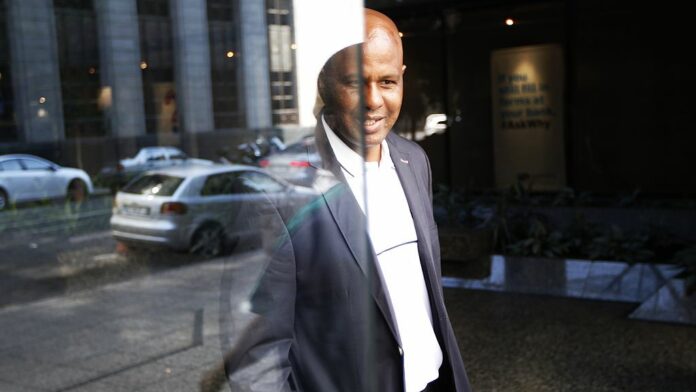
UNIONS in South Africa’s mining sector have never been so united. Tellingly, this may be a sign of weakness in the wider labour movement: confronting the mining industry alone can have unintended consequences. But it is also no bad thing for all stakeholders, including union members and management. As the 10th anniversary of the Marikana Massacre approaches, there has been far less violence in the sector of late stemming from union rivalry. And with one recent and very notable exception, the uniting of rival unions in wage talks has produced decent wage agreements without the downing of tools.
This does not mean that it is all a bed of roses. There are thorns galore among the petals. The National Union of Metalworkers of South Africa (NUMSA) has launched a recruitment drive in the sector, causing disruptions at companies such as Impala Platinum. The militant Economic Freedom Fighters (EFF), a breakaway from the ruling African National Congress (ANC), has established a labour desk with an online presence and signalled its intention to form its own union. Sources say that EFF recruiters have already attempted to woo members of the dominant National Union of Mineworkers (NUM) and the Association of Mineworkers and Construction Union (AMCU).
There are also clear signs that social unrest and outright criminal activity are on the rise, posing material threats to mining operations. But at least labour tensions seem to be cooling.
The driving force behind this state of affairs is the end of the turf war between NUM and AMCU. This is without question the most significant development in labour relations in South Africa’s mining sector since the explosive rise of AMCU a decade ago on the platinum belt.
Violence stemming from union rivalry has been largely contained, with some pointed exceptions. The three-month strike the two unions embarked on together at Sibanye-Stillwater’s South African gold operations, which ended in June, stood out for its lack of violence.
The contrast with the previous industrial action at Sibanye’s gold mines is striking. AMCU members were alone in downing tools at those operations in late 2018 and did so for five months, triggering unrest that killed nine people and saw 60 houses of NUM supporters torched on the restive West Rand. This followed a familar pattern: AMCU strikes have almost always been linked violence, though it has always denied that it resorts to such tactics.
But AMCU also lost big time in that strike after its members had to accept the same wage offer that rival unions had agreed to – and after losing five months’ worth of wages. That shook AMCU’s seemingly iron grip on its membership, including that of its charismatic founder and leader, Joseph Mathunjwa.
A subsequent confluence of events including the Covid-19 pandemic would bring the unions together and blunt AMCU’s militancy.
Covid collective
Amid the tough lockdowns on 2020 which took a wrecking ball to the wider South African economy, the mining industry was given the green light to reboot ahead of other sectors. That required inter-union cooperation on an unprecedented scale.
“Health and safety were the drivers – unions joined forced to protect vulnerable workers under Covid,” Gideon du Plessis, the General Secretary of the Solidarity union which mostly represents skilled workers, he says in an interview.
“We stood together to protect vulnerable workers from retrenchment. Then, to get the mines going again, we had to speak from one voice, and then we had to have a joint stance on vaccination.”
Meanwhile, other trends related to the pandemic were undermining Mathunjwa’s style of leadership. A passionate public speaker from a Salvationist Christian background, one of Mathunjwa’s assets has always been his ability to work a crowd with a message that combines an intense Biblical faith with African nationalism and Marxist doctrine.
Covid restrictions brought an end to the AMCU rallies where Mathunjwa took centre stage, robbing his status of vital oxygen. Mathunjwa on a Zoom meeting is just not the same.
Mathunjwa has also faced legal setbacks in the form of a Labour Court decision in late 2021 that declared his 2019 reelection to the post of AMCU president unlawful. An appeal process is allowed and Mathunjwa does seem to remain broadly in charge.
And while Mathunwa’s public remarks remain familiar, attacking “white monopoly capital” and its alleged declaration of “war” on the black working class, AMCU’s actions suggest it is no longer taking off the gloves and replacing them with brass knuckles.
“This shows that AMCU is like any other union, it is there to strike compromises with management. It seemed to come in with a different sort of unionism. But it has become highly institutionalised. It is a sign that it is maturing,” Crispen Chinguno, a senior lecturer at Sol Plaatje University, who has studied AMCU extensively, says.
The straight-talking Mabapa has an earthy style – he is a miner – and is focused on bread and butter, shop floor issues.
“AMCU cannot resort to violence because they are now part of the system. Before they were outside. But now they are inside the tent. They have to conform to the rules of the game,” he said.
Mathunjwa also now speaks of “NUMCU”, though union sources say there is currently no merger in the works.
Ironically, the decline in labour violence linked – fairly or unfairly – to AMCU is no bad thing for the capitalists Mathunjwa rails against.
This labour violence and instability for the better part of the past decade has been one of the material threats to South Africa’s mining sector, and has set in motion trends such as the pivot to mechanisation. The dousing of these flames is positive for the industry’s risk profile.
Take, for example, the Marikana Massacre, in which South African police shot dead 34 miners involved in a chaotic wildcat strike in August 2012. This was the beginning of the end for Lonmin as the event rendered the asset toxic in the eyes of many investors.
The patch-up of relations between NUM and AMCU began among rank and file workers who just wanted to get on with their jobs without coming into conflict with peers. At the leadership level, it has been spearheaded by NUM General Secretary William Mabapa and AMCU’s main negotiator, the soft-spoken Jimmy Gama who is almost like a Dr. Jekyll to Mathunjwa’s Mr. Hyde.
The straight-talking Mabapa has an earthy style – he is a miner – and is focused on bread and butter, shop floor issues.
“Why should we be fighting among ourselves?,” he told this correspondent in a recent inteview.
Returning to Covid-19, the pandemic has been a double-edged sword for the mining sector’s union rank and file. On the one hand, the relatively brisk restart of the mines – and the policy of several companies to pay regular wages and benefits to workers forced to stay home – meant that miners were spared the worst of the economic hardship that slashed the incomes of other workers.
This helped to build trust between employees and management. The restaurant sector, for example, could hardly afford to pay workers who were marooned at home for months.
This is where the sword’s other edge has come into play.
The typical mine worker is estimated to have eight to 10 dependants, and while there is no hard data yet on this, it must almost certainly the case – based on broad economic indicators – that those numbers have swelled. South Africa’s unemployment rate hit a record high of 35.3% in the fourth quarter of 2021 before dipping slightly to 34.5% in the first quarter of this year.
Mining in pointed contrast added jobs. According to data compiled by the Minerals Council South Africa – the main body representing the industry – the sector employed in 458,954 people in 2021 compared to 452,866 in 2020. And it paid employees R154bn in 2021 compared to R152bn in 2020, when many of its operations were temporarily halted.
So miners broadly maintained their incomes, which has poured cold water on calls for class conflict. Simultaneously, many will have family members who lost their income stream, placing additional strains on working and even middle-class household finances.
And this is state of affairs is playing out as inflation accelerates, driven by fuel and food prices. Consumer inflation in the year to May quickened to 6.5% from 5.9%. Interest rates are also on the rise which will squueze households burdened by debt.
This combination of factors will likely keep keep wage demands above inflation for the foreseeable, while dulling the sharper edges of union combativeness.
Commodity cycle
And fortuitously, from the economic wreckage of the pandemic a renewed commodity super cycle has emerged. Like their global peers, South African mining companies have been posting record profits largely from record prices. This has enabled the settling of above-inflation wage hikes involving multiple unions without industrial action.
Harmony Gold’s historic three-year wage agreement with five unions including NUM and AMCU in September 2021 set the stage on this front. Anglo American Platinum followed suit with a five-year wage deal this year with several unions that effectively amounts to annual pay hikes of over 7%. Several other miners have also clinched deals without their employees going on strike.
The upshot of all of this has been – with the buffalo-sized exception of the three-month strike at Sibanye’s gold operations – almost a “new normal” in labour relations, extending from the shafts to the boardroom. It is certainly a jarring juxtaposition with a decade ago, in the turbulent run up to the events at Marikana. There remain potential spanners in the works.
AMCU cannot resort to violence because they are now part of the system. Before they were outside. But now they are inside the tent.
The upcoming wage talks at Sibanye’s PGM mines will be an important test case. They come at a poignant time as the Marikana anniversary looms in the background. And Sibanye-Stillwater now owns the Marikana mine, a formerly marginal asset that has returned to profitability.
Was the three-month Sibanye gold strike a dress rehearsal for a Rustenburg rumble?
There has been speculation that this is the case. Unions across the board, from AMCU to Solidarity, take an extremely dim view of Sibanye-Stillwater and its blunt-mannered CEO Neal Froneman, whose mostly R300m pay package last year has stoked their ire.
Sibanye’s approach to negotiatons and its handling of the strike have also raised labour hackles. Among other things, according to more than one labour source, the company’s strategy of frequently sending its striking employees direct messages irritated the unions.
For its part, Sibanye has maintained that it was not as inflexible as the unions have portrayed it, and increased its offer a number of times in the face of a rigid demand of R1,000 a month each year, mirroring the Harmony deal.
There is also a labour perception that Sibanye-Stillwater buys assets only to mothball them. It must be said that its turnaround of the Marikana asset, which has saved thousands of jobs, flies in the face of that narative.
Sibanye-Stillwater will also not be able to plead the case that it does not cross-subsidise its assets. Its gold mines are far more marginal than its cash-spinning PGM operations. On the other hand, as the middle of the year approaches, PGM prices are well down from their peaks as the outlook for the global economy dims.
And labour still faces disruptive trends – spurred in part by union unrest – such as mechanisation, digitisation, and automation. In the face of these developments, a united strategy may still be labour’s best bet.
Meanwhile, NUMSA’s membership drive which hit production at Implats last year is no longer a headache for the company.
Industry sources say that was partly related to the assassination last year of a NUMSA organiser in Rustenburg. But the EFF’s drive to start its own union may crank up a gear in the shadow of the 10th anniversary of the Marikana Massacre. That was an event that the EFF latched onto to gain traction after its firebrand leader Julius Malema was expelled from the ANC. Expect the party to still exploit the incident politically.
This article first appeared in The Mining Yearbook 2022 which can be accessed free of charge here >>










